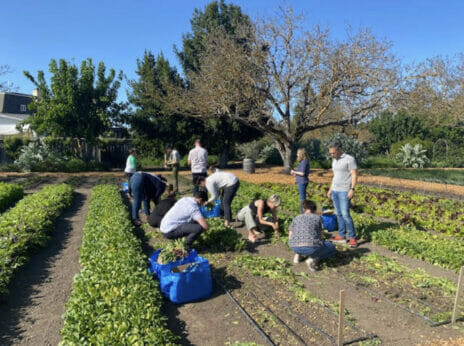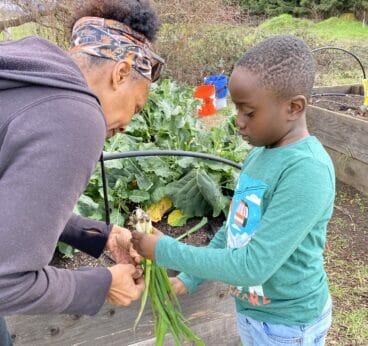In light of massive food insecurity, local organizations are looking to solve the problem through neighborhood gleaning.

It’s a late winter morning, and I’m overwhelmed. As I stand beneath the verdant green tree, close to 1,000 ripe pomelos tug on the branches, threatening to fall. I pluck a particularly stubborn fruit with the long-armed gleaning tool, causing a second grapefruit-sized bomb to descend and thwack my fellow volunteer on the shoulder.
We’re just two in a small group of volunteers. We’re standing in the front yard of a private home that invited the nonprofit Farm to Pantry, of Healdsburg, California, onto their property. Our task: Collect the large, golden pomelos from a huge tree standing in the fenced-in front yard. This is just one of more than 400 properties in Sonoma County that permits Farm to Pantry to take their extra (or in some cases ugly) produce from their land to give it to those in need.

Photography courtesy of Farm to Pantry.
Farm to Pantry started in 2008, when founder Melita Love noticed endless tree branches bending under the weight of fresh citrus; a few days later, unharvested, she knew those same fruits would litter yards and rot on the ground.
Sonoma County is responsible for much of the Bay Area’s fresh fruits and vegetables, yet Love knew that a large percentage of her neighbors (recent reports have shown anywhere from one in five to one in three residents) experienced food insecurity. Baffled that an extreme surplus and an extreme need could exist in the very same place, Love started Farm to Pantry. The non-profit works to harvest the unwieldy and unwanted surplus from farms and backyards and deliver the yield to those who need it most.
Homeowners can instruct Farm to Pantry to pick all of their fruit, to leave a certain percentage of the fruit or vegetables on the tree or plant or to gather all the produce while leaving some of the plucked fruits on the porch for their own consumption. Executive director Duskie Estes often runs the gleans. Sometimes, they’re in a backyard like the one with the pomelos; other times, she has permission to harvest crops from farms such as SingleThread, the private farm owned by the three-star Michelin restaurant of the same name.
This particular homeowner wanted all of their pomelos gone. Not only would the citrus help to feed the community, we volunteers were preventing a nasty situation: If left unpicked, the pomelos would drop onto the lawn, rot in the yard and then, like the 30%- 40% of all food in the United States, get trucked off to a landfill. This trucking and methane gas release would of course also add to global warming. According to its website, Farm to Pantry estimates that its effort to curb food waste by rescuing more than 400,000 pounds of produce each year is the equivalent of taking 1,102 cars off the road for a year.
Gleans happen across the country through hundreds of organizations. Most of these nonprofits have similar missions—get nutritious food to the people who need it most and prevent food waste largely through the efforts of volunteers. However, each gleaning organization has a slightly different model, depending on what grows. In Kansas City, After the Harvest visits the endless farms to gather leftover, unharvested produce that could not be sold or that has graded out, distributing it all to food banks around the Kansas City area.
“Our work has meant more fresh produce for low-income, food-insecure families, children and seniors and better health outcomes as a result of this improved access to fresh food,” says Lisa Ousley, founder of After the Harvest.
In Maine, the Maine Gleaning Network comprises seven community gleaning initiatives that combine forces to secure thousands of meals from farms across the state. And in Seattle, City Fruit gleans more than 40,000 pounds of fruit each year to distribute locally. Even outside of the growing season, City Fruit works year-round to educate the next generation of orchardists and to care for fruit trees, which guarantees a bounty of fruit for the next year’s harvest.
But gleaning doesn’t just happen on farms and fields. There’s urban gleaning at grocery stores and gleaning of fish in the sea. In New Jersey, for instance, Americas Gleaned Seafood (AGS) works with local fishermen to put a process into place so that bycatch can go to those in need. Otherwise, bycatch—the non-targeted species that can’t be sold off but is often perfectly fine meat—would get tossed overboard. And since all hauled-in fish brought into the state’s ports is 20 percent bycatch, AGS prevents literally tons of waste and delivers nutritious meat to those in need, gleaning everything from low-valued fish to the pounds of tossed-away, superb flesh that’s cut from a tuna or swordfish’s tail prior to being weighed.
“I think everyone who fishes comes up with the idea of gleaning seafood the very first time they go fishing,” says Brick Wenzel, founder of AGS, who describes his first fishing experience as disappointing and eye-opening. After taking the fish off the hook, he threw it back in the water and watched the fish float there. “You have taken something out of its ecosystem, killed it and threw it away… Stopping the waste in fishing and giving the fish to people who would eat it started as a childhood dream.”

Photography courtesy of Farm to Pantry.
While growing the non-profit had been slow back in the aughts, COVID changed everything for Farm to Pantry and many other gleaning organizations. Restaurants shut down, farmers in the area lost their top buyers—especially in Sonoma County where most farms serviced farm-to-table establishments and couldn’t easily transition to a grocery model—and many people wanted to help their communities by doing things outside.
“Five hundred people started to volunteer,” Estes says about the organization’s growth during the pandemic. With the abundance of volunteers and participating farms and properties, Farm to Pantry gleans enough food that it’s able to offer a full day’s meal to 900 people in Sonoma County each day.
Estes squints up at the branches and those golden orbs tugging them toward the earth. A crown tattoo on her forearm flexes as she rips down a softball-sized fruit. She got the tattoo after being dubbed the Queen of Pork during the Grand Cochon at Aspen Food & Wine, where she had bested Thomas Keller and dozens of other world-renowned chefs to become the first female chef to win this prize.
Estes has always focused on ethical sourcing of food and for advocating for small farmers. The former vegetarian now owns and operates a food truck that serves ethically raised pigs, taking a snout-to-tail approach. Her work at Farm to Pantry allows her to extend her efforts to those in her community most in need.
“As a chef, I only got to give lucky people food,” says Estes. “Now, I get to give everyone food.”
Gleaning also fits in perfectly with the tourism industry. After all, in a place like Sonoma County—visited largely for its wine region—most vineyards don’t open until 11a.m. and there’s only so much wine a person can (or should) drink throughout the day. So, it just made sense that with a morning to spare, I do something with purpose between 9 and 11. Not only was I helping to feed this welcoming community, but gleaning allowed me to learn about the soil and plants that would nourish me and inebriate me during my time in the county.
I added a pomelo to the bucket, the last needed to fill it. Another Farm to Pantry volunteer lifted the container and struggled, carrying it over to the truck. A lot of good could be done in a morning.
How many people who need the food are volunteering to go out and help to gather it? Everyone who uses a food bank should be given the opportunity to volunteer.
It is important to boost local production
What percentage of those in need are offering to assist gather the food? It is only fair that those who utilize food banks be offered the chance to volunteer.